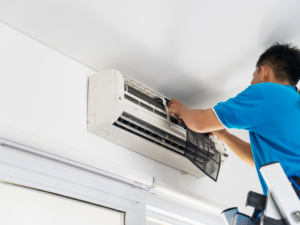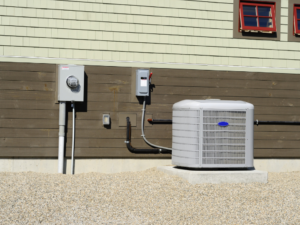Indoor air quality is an often overlooked but important factor in maintaining a healthy living environment. Indoor air pollutants can cause a range of health problems, from minor irritations to more serious long-term illnesses. Poor indoor air quality can have significant implications on our overall health and well-being. In this article, we will discuss the various sources of indoor air pollution, their effects on human health, and ways to improve your home’s indoor air quality.
Indoor Air Quality: The Causes and Effects on Health and Well-Being
Indoor air quality can have a significant impact on your health and well-being. Indoor air pollution can come from a variety of sources both inside and outside of your home, which can affect how healthy the air inside your home is. Indoor air pollutants come in two categories: particulate matter and gaseous pollutants.
Particulate matter is a common indoor air contaminant, including dust particles, pollen, animal dander, and mold spores. These particles are small enough to become airborne and be inhaled by humans. Inhaling these particles can cause eye and throat irritation, coughing, and shortness of breath, as well as other more serious long-term consequences such as respiratory illnesses or allergies. Particulate matter is also responsible for triggering asthma attacks in asthmatics due to its ability to penetrate deep into the lungs.
Gaseous pollutants include volatile organic compounds (VOCs), carbon monoxide, nitrogen dioxide, formaldehyde, and sulfur dioxide, all of which are carcinogenic and can contribute to poor indoor air quality. VOCs have emitted from products such as paint strippers and solvents; carpets; furniture; aerosol sprays; cleaning supplies; detergents; flame retardants; pesticides; adhesives; plastics; tobacco smoke; gasoline fumes from automobiles or lawnmowers; cooking fumes from gas stoves or fireplaces; exhaust from furnaces or boilers that burn natural gas or oil fuels; kerosene space heaters or wood burning stoves/fireplaces. Exposure to VOCs can cause headaches, dizziness, loss of coordination, nausea, and skin problems among other symptoms depending on the individual’s sensitivity level. Carbon monoxide is another dangerous gaseous pollutant that comes from fuel-fired appliances like furnaces as well as cars running in attached garages. It’s colorless and odorless so it’s hard to detect but it can cause serious health issues like brain damage if exposed too often at high levels over time.
Poor indoor air quality has been linked to an increase in respiratory illnesses such as asthma attacks or allergies as well as chronic diseases such as cancer or cardiovascular disease when exposed to higher levels of indoor pollutants over time. It’s important not only for people with pre-existing conditions like asthma to be aware of their indoor environment but everyone should be aware of potential hazards present in their homes no matter what their condition is because everyone breathes the same type of air inside regardless if they have any existing medical conditions or not.
There are a few things you can do to improve the quality of your home’s air: keep windows open whenever possible to allow fresh outside air into your home; use exhaust fans when cooking, showering, or doing laundry; regularly clean carpets, and rugs, curtains, walls, baseboards, and other surfaces; be sure all fuel-burning appliances are properly vented outside; minimize smoking indoors; inspect your home for signs of water damage or mold growth caused by high humidity levels. By taking these steps you will significantly reduce the number of pollutants in your home’s Indoor Air Quality thus improving overall health outcomes for yourself and family members living within your property.
Indoor Pollutants & Their Impact on Indoor Air Quality
Indoor air pollution is a serious health concern, with indoor pollutants like particulate matter and gaseous pollutants having the potential to cause eye and throat irritation, coughing, shortness of breath, respiratory illnesses, allergies as well as more serious long-term consequences such as asthma attacks or cancer. Indoor air pollution can come from a variety of sources both inside and outside of your home, including dust particles, pollen, animal dander, mold spores, volatile organic compounds (VOCs), carbon monoxide, nitrogen dioxide, formaldehyde, and sulfur dioxide. All of these contaminants can have an adverse effect on Indoor Air Quality (IAQ).
The most common type of indoor pollutant is particulate matter. These tiny pieces of dust or dirt can become airborne and be inhaled by humans when breathed in they can lead to various health problems including eye and throat irritation, coughing and shortness of breath. Particulates are also responsible for triggering asthma attacks in asthmatics due to their ability to penetrate deep into the lungs. Gaseous pollutants also pose a danger to Indoor Air Quality with VOCs emitted from products such as paint strippers and solvents; carpets; furniture; aerosol sprays; cleaning supplies; detergents; flame retardants; pesticides; adhesives; plastics; tobacco smoke; gasoline fumes from automobiles or lawnmowers; cooking fumes from gas stoves or fireplaces; exhaust from furnaces or boilers that burn natural gas or oil fuels; kerosene space heaters or wood burning stoves/fireplaces all having the potential to cause headaches, dizziness nausea skin problems among other symptoms depending on the individual’s sensitivity level.
Carbon monoxide is another dangerous gaseous pollutant that comes from fuel-fired appliances like furnaces as well as cars running in attached garages. It’s colorless and odorless so it’s hard to detect but it can cause serious health issues like brain damage if exposed too often at high levels over time. Indoor air pollution has been linked to an increase in respiratory illnesses such as asthma attacks or allergies as well as chronic diseases such as cancer or cardiovascular disease when exposed to higher levels of indoor pollutants over time.
Fortunately, there are several steps you can take to improve Indoor Air Quality: keep windows open whenever possible to allow fresh outside air into your home; use exhaust fans when cooking showering, or doing laundry regularly clean carpets rugs curtains walls baseboards and other surfaces are sure all fuel-burning appliances are properly vented outside minimize smoking indoors inspect your home for signs of water damage or mold growth caused by high humidity levels Taking these steps will help reduce the number of pollutants in your home’s Indoor Air Quality creating healthier living conditions for yourself and family members living within your property.
Understanding the Link Between Indoor Air Quality & Chronic Illnesses
Having healthy Indoor Air Quality is essential to maintaining good health, especially when it comes to chronic illnesses. Indoor air pollutants such as dust particles, pollen, animal dander, mold spores, volatile organic compounds (VOCs), carbon monoxide, nitrogen dioxide, formaldehyde, and sulfur dioxide can have adverse effects on one’s Indoor Air Quality (IAQ) and can lead to to the development of chronic illnesses.
Research has shown that long-term exposure to high levels of indoor air pollution can lead to an increased risk of developing chronic illnesses like cancer or cardiovascular disease. VOCs produced by common household products such as paint strippers and solvents; carpets; furniture; aerosol sprays; cleaning supplies; detergents; flame retardants; pesticides; adhesives; plastics; tobacco smoke and more can cause headaches, dizziness nausea skin problems depending on the individual’s sensitivity level. Carbon monoxide is another dangerous gaseous pollutant that comes from fuel-fired appliances like furnaces as well as cars running in attached garages. It’s colorless and odorless so it’s hard to detect but it can cause serious health issues like brain damage if exposed too often at high levels over time.
Fortunately, there are several steps people can take in order to improve Indoor Air Quality such as keeping windows open whenever possible to allow fresh outside air into your home, using exhaust fans when cooking showering, or doing laundry regularly cleaning carpets rugs curtains walls baseboards, and other surfaces being sure all fuel-burning appliances are properly vented outside minimizing smoking indoors inspecting your home for signs of water damage or mold growth caused by high humidity levels and more. Taking these steps will help reduce the number of pollutants in your home’s Indoor Air Quality creating healthier living conditions for yourself and family members living within your property.
Additionally, people should be aware of their Indoor Air Quality levels while they are away from home by checking local IAQ readings which are usually posted online by local governments in major cities across the world or checking out portable Indoor Air Quality monitors that measure particulate matter temperature and humidity levels indoors so people know when they need to move away from an area with poor Indoor Air Quality levels.
By understanding what Indoor Air Pollutants exist in our homes we can take steps towards improving our overall Indoor Air Quality level thus reducing our risk of developing chronic illnesses down the road due to long-term low-quality Indoor Air Exposure.
The Benefits of Improving Indoor Air Quality
The health benefits of improving Indoor Air Quality (IAQ) are immense. Indoor air pollution can contain harmful pollutants such as dust particles, pollen, animal dander, mold spores, volatile organic compounds (VOCs), carbon monoxide, nitrogen dioxide, formaldehyde, and sulfur dioxide which can have an adverse effect on our health over time. Long-term exposure to high levels of indoor air pollution can lead to the development of chronic illnesses such as cancer and cardiovascular disease. In addition to the health risks associated with Indoor Air Pollution, there are also financial implications with poor Indoor Air Quality as people may be required to spend more money on medical bills related to their Indoor Air Quality related health issues.
Thankfully, there are many ways that we can improve Indoor Air Quality in our homes, workplaces, and other enclosed areas. By regularly cleaning carpets, rugs curtains walls baseboards, and other surfaces; making sure all fuel-burning appliances are properly vented outside; minimizing smoking indoors; inspecting your home for signs of water damage or mold growth caused by high humidity levels; using exhaust fans when cooking showering or doing laundry; opening windows whenever possible to allow fresh outside air into your home; checking local Indoor Air Quality readings or investing in a portable IAQ monitor you can reduce the amount of Indoor Air Pollutants in your home significantly. Doing so will create healthier living conditions for yourself and family members living within your property thus reducing the risk of developing chronic illnesses due to long-term low-quality Indoor Air Exposure. The long-term health benefits of improving Indoor Air Quality should not be underestimated as it can provide numerous positive outcomes for both individuals and society at large. For individuals, improved Indoor Air Quality leads to better overall physical well-being with reduced symptoms and diseases associated with breathing polluted air. Furthermore, it helps increase productivity and creativity while creating a healthier environment for children who often spend a lot of their time indoors playing or studying.
On a larger scale improved Indoor Air Quality has many societal benefits such as reducing workdays lost due to sick leave thus increasing economic productivity; reducing burial costs from deaths due to exposure to poor Indoor Air Quality; providing social justice by ensuring those living in poorer quality housing do not suffer disproportionately from sicknesses caused by Indoor Air Pollution; helping protect delicate ecosystems that may be destroyed if exposed to higher concentrations of pollutants emitted from our homes etc.
Conclusion
Indoor air pollution can have serious consequences for our health and well-being, but there are many ways we can improve Indoor Air Quality in our homes. By regularly cleaning surfaces, inspecting our home for mold and water damage, using exhaust fans when necessary, and investing in Indoor Air Quality monitors, we can reduce the amount of Indoor Air Pollutants significantly. This will create healthier living conditions and provide numerous positive outcomes on both an individual level as well as a societal one.




